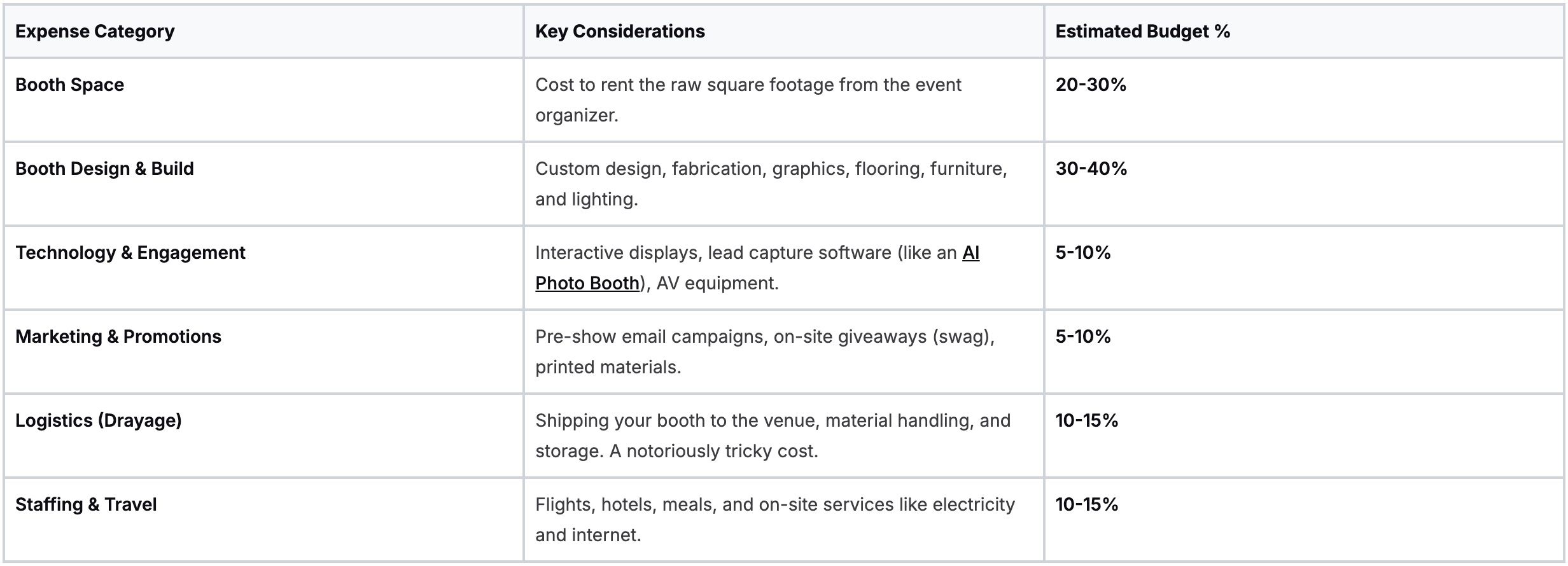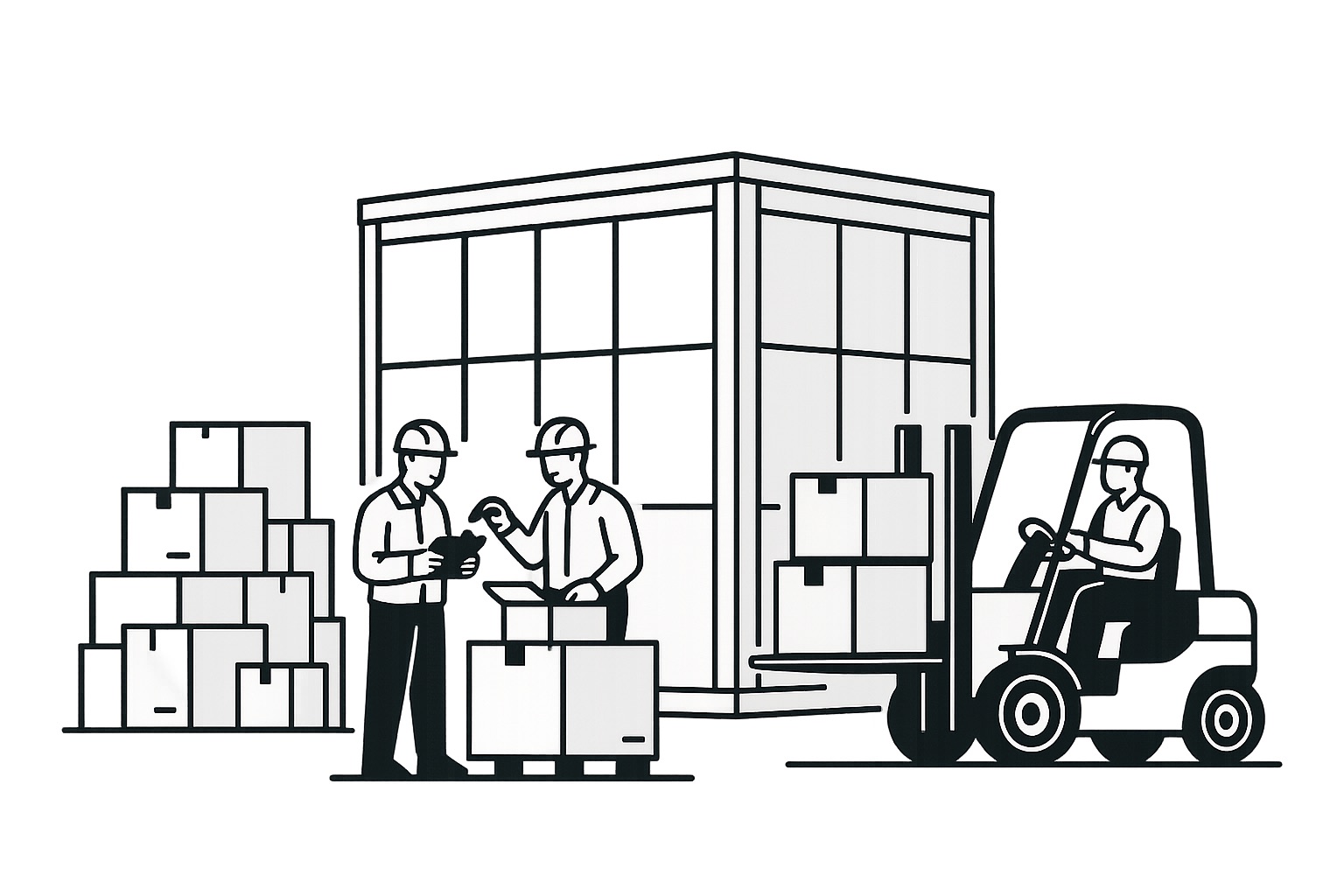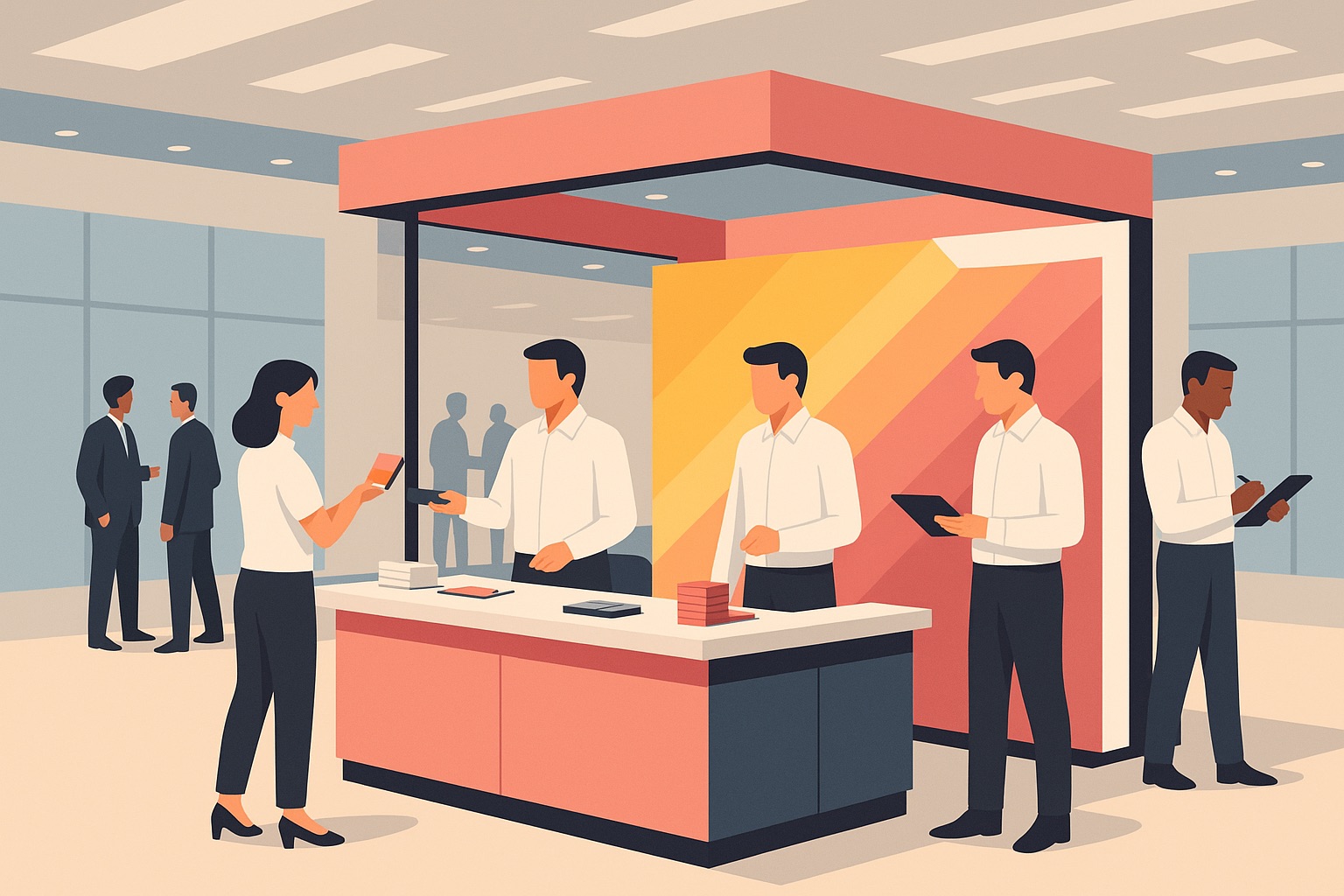A great trade show booth is more than just walls and carpet. It’s a strategic play that starts with crystal-clear business goals. Every successful booth we've seen directly ties back to its core purpose, whether that’s generating leads, boosting brand awareness, or launching a new product.
Building Your Booth Strategy From the Ground Up
Your most impactful work happens long before you ever set foot on the event floor. Every single decision, from the size of your booth to the tech you pack, should be a direct reflection of your strategy. This is how you make sure every dollar spent and every conversation had actually moves the needle on what matters.
It all boils down to your "why." Are you there to stuff your sales pipeline with quality leads? Is the main goal to get your brand in front of a totally new market? Or maybe you're showing off a new product to existing customers and partners.
Your primary objective dictates every choice you make from here on out. A booth built for high-volume lead capture is going to look and feel completely different from one designed for in-depth, high-touch product demos. Get this part clear first. It's non-negotiable.
Aligning Objectives with Your Audience
Once you've nailed down your goals, it's time to get inside the heads of the event attendees. Who are they? What keeps them up at night? And how does your solution make their lives easier? Digging into attendee demographics helps you craft messaging that lands with maximum impact.
Your booth needs to speak their language. If the crowd is highly technical, your displays and conversations should zero in on specific features and integrations. If you're talking to C-suite decision-makers, you'll want to shift the focus to ROI, business value, and strategic partnerships.
Budgeting for a Successful Setup
Nailing down a realistic budget is one of the most critical parts of planning your trade show booth. A classic rookie mistake is focusing only on the floor space and the physical booth, completely underestimating all the other costs that sneak up on you. A solid budget prevents that last-minute financial panic and lets your team bring its vision to life.
Planning for these expenses from the get-go is the only way to go. It gives you a financial roadmap that lines up with your strategic goals, ensuring no critical piece gets left behind because of a budget oversight. This foundational work separates a forgettable booth from one that delivers a real return on investment.
Trade Show Booth Budgeting Checklist
A well-thought-out budget is your best defense against surprise costs. Use this checklist to map out your expenses and allocate your funds effectively.

Don't forget that staffing is a significant chunk of the pie. Research shows that over 14% of exhibitor budgets are spent on business accommodations alone, a fact you can dig into with other trade fair statistics here. Factoring this in from day one is essential for a realistic plan.
Designing a Booth That Captures Attention
Your booth design is your first, and most powerful, handshake on the trade show floor. It's the visual hook that stops a distracted attendee mid-stride and pulls them into your world. An effective design moves beyond just looking good; it's an immersive and functional space engineered to guide visitors toward meaningful conversations.
This means translating your brand’s identity into a physical environment. We're talking about using color psychology, strategic lighting, and specific materials to create a deliberate mood. A bright, airy space with natural wood tones feels collaborative and open, while a darker theme with neon accents can come across as more exclusive and high-tech.

Crafting a Strategic Layout
The flow of your booth is just as important as its looks. A cluttered or confusing layout creates friction and discourages people from even entering. The goal should always be an open, inviting floor plan that encourages traffic and prevents those awkward bottlenecks right at the entrance.
Think about creating distinct zones within your space, each with a clear purpose:
- A "Hook" Zone: This is your frontline, the area designed to grab attention with a compelling interactive element. An AI photo booth is perfect here because it generates genuine excitement and visually interesting content that naturally draws people in from the aisle.
- A Demo Area: Set aside a specific space for hands-on product demonstrations. This should be slightly removed from the main traffic flow to allow for more focused, one-on-one conversations.
- A Casual Conversation Nook: Even a small area with comfortable seating encourages longer, more relaxed discussions away from the hustle and bustle.
When you're ready to visualize how this all fits together, tools like an event floor plan creator can be invaluable. They help you optimize the space and flow before you commit to a final design.
The most successful booths are designed with a clear pathway in mind. They guide an attendee from initial curiosity at the edge to deep engagement at the core, making the journey feel natural and unforced.
This focus on design is validated by what we see across the industry. In-person events are seeing a major resurgence, with 95% of exhibitors preferring them over virtual alternatives. For a deeper look at what it takes to draw a crowd at your tradeshow booth, check out our guide on creating engaging experiences.
Making Graphics That Speak Volumes
You have about three seconds to communicate your core message to a passerby. Your graphics have to do all the heavy lifting, delivering a clear and powerful statement almost instantly. This is not the place for dense paragraphs of text or confusing industry jargon.
Focus on these key elements for powerful visual communication:
- Bold Typography: Use a large, clean font for your main headline. It must be legible from a distance and immediately state what problem you solve or what value you offer.
- High-Impact Imagery: Go with a single, compelling hero image or a very short, looping video that showcases your product or brand in action. Avoid busy collages that dilute the message.
- A Clear Focal Point: Every design needs a centerpiece. This could be your main graphic, a large video screen, or a unique structural element. This focal point is what initially draws the eye and anchors the entire design.
The importance of aesthetics can't be overstated. Recent data shows that a whopping 48% of exhibitors identify eye-catching displays as the top tactic for attracting attendees. With lead generation (36.4%) and brand exposure (29%) as top priorities, investing in a visually stunning setup is a direct investment in your event goals. As more companies plan to increase their exhibiting frequency, a standout design becomes a key differentiator.
Weaving Tech into Your Booth for a Modern Experience
A great booth design makes people stop in their tracks. But it's the right technology that convinces them to stay, play, and remember you long after they've left the hall. In a sea of competitors, tech is what turns a passive glance into an active, memorable brand interaction.
This isn't about loading up your booth with gadgets for the sake of it. It’s about being intentional. You’re choosing tools that directly support your event goals, whether that’s a massive LED video wall broadcasting your message or a more intimate, hands-on interactive screen.
Keep in mind, for any of this to work seamlessly, rock-solid internet is non-negotiable. Don't let spotty Wi-Fi derail your expensive tech investments. It’s worth looking into setting up secure and reliable guest WiFi to ensure both your team and your visitors have a smooth experience.
Crafting Shareable Moments with Interactive Tech
The ultimate win in event marketing is creating an experience so cool that attendees can't resist sharing it online. This is where interactive tech truly proves its worth, amplifying your brand's reach far beyond the convention center floor.
Consider an AI-powered photo booth. It’s not just taking pictures; it’s creating unique, branded content that people immediately want to post. This kind of user-generated content is an authentic endorsement of your brand, reaching an audience you could never tap into with a simple ad. Suddenly, every participant is a mini-influencer for you.
Another powerful option is a video testimonial booth. It’s the perfect way to capture genuine customer stories right on the spot. These short, authentic clips are pure gold for your future marketing campaigns, adding a layer of social proof that's hard to replicate.
The best technology integrations aren't just tacked on, they're woven into the very fabric of the booth experience. They create a natural "pull," drawing people in with the promise of a fun, personalized, and unique interaction.
These tools are also lead-capture powerhouses. By asking for an email or social handle to send the content, you're not just collecting contacts; you're getting information from people who have already had a positive, memorable moment with your brand. These are the warmest leads you can get.
Picking the Right Tech for Your Goals
The technology you choose should be a direct answer to the question: "What are we trying to achieve here?" Are you aiming for a massive number of new leads? Do you need to run in-depth product demos? Or is your main goal to create a huge brand buzz? Each objective points to a different tech solution.
To make the decision a bit easier, let's break down some of the most effective interactive technologies based on what they do best and their potential for capturing data. This should help you align your tech stack with what you actually want to get out of the show.
Interactive Tech Comparison for Booth Engagement
Here’s a look at a few popular technologies to help you decide which one best fits your specific goals and target audience at the trade show.

At the end of the day, the goal is to make it all feel seamless. The tech should feel like a natural part of your booth's story, not a clunky, confusing add-on. Make sure your team is well-versed in how everything works and can confidently guide visitors through the experience. When your tech, design, and staff all work in harmony, you've created a powerful combination that drives traffic, captures quality leads, and leaves a lasting impression.
Mastering On-Site Booth Management and Execution
All the strategic planning and brilliant design in the world won’t matter if the on-site execution falls flat. This is where the rubber meets the road. The moment those trade show doors swing open, your focus has to shift from planning to performance. Your team becomes the living, breathing embodiment of your brand, and every single interaction counts.
It all starts with a flawless setup. Arrive with a clear plan, knowing exactly how your booth components fit together. Don't try to wing it. Mastering the process of hiring equipment for events ahead of time is crucial for a smooth setup and a successful show. Make sure you have a designated point person to manage vendors and troubleshoot the inevitable logistical hurdles. They almost always pop up.

Equipping Your Team For Success
Your booth staff is your single most important asset on the show floor. We’ve seen it a hundred times: a beautiful, expensive booth with a passive or unprepared team is a massive missed opportunity. Proper training is what transforms your staff from people who just stand there into expert brand ambassadors and relationship builders.
Before the event, we always recommend running through role-playing exercises. This helps your team practice navigating different conversations, from the quick "what do you do?" pitch to deeper discovery questions. The goal is to build their confidence so they can move beyond just scanning badges and actually connect with people.
A well-trained team doesn't wait for attendees to approach them. They are proactive, armed with open-ended questions that spark genuine conversations and efficiently qualify visitors.
Give everyone clear, measurable goals. This could be targets for qualified lead captures, product demos delivered, or meetings booked for after the show. When your team knows what success looks like, they're far more motivated to go out and achieve it.
The Art of Proactive Engagement
Engaging attendees is about creating a pull, not a push. Instead of a generic "Can I help you?", which almost always gets a "No, thanks," train your team to use observational opening lines. It’s a game-changer.
Here are a few tactics for sparking real conversations:
- Comment on their badge: "I see you're with [Company Name]. We actually work with a few of your competitors. What brings you to the show today?"
- Reference their activity: "I saw you checking out our demo screen. What part caught your eye?"
- Use your interactive tech: "Have you tried our AI photo booth yet? It's a fun way to see our tech in action."
These approaches are disarming and open the door to a more natural dialogue. It shows you're paying attention and are interested in them as a person, not just their contact information. You can learn how to use an online photo booth for successful event engagement in our detailed guide.
Managing Booth Traffic and Energy
A busy booth is a great problem to have, but it needs to be managed or it becomes chaos. Have a plan for handling rushes. This could mean a simple queueing system for a popular interactive element or having team members designated to triage visitors.
It's also vital to schedule regular breaks for your staff. Standing for hours and constantly talking is exhausting. A tired, low-energy team is an ineffective team. Rotate your staff to make sure everyone stays fresh, sharp, and enthusiastic.
This proactive approach is more important than ever as the trade show industry continues its strong recovery. The market is seeing renewed investment, with a notable 18.4% increase in the number of exhibitors from 2024 to 2025. This growth means more competition and a greater need for flawless on-site execution to stand out from the crowd.
Driving ROI with Post-Show Follow-Up
The trade show doesn't end when they dim the lights on the exhibit hall floor. For your ROI, the most important part is just getting started. The post-show hustle is where all that effort, engagement, and budget gets turned into real, measurable business.
Think of the leads you collected as potential energy. Your job now is to convert that potential into business growth through a smart, quick, and personal follow-up strategy. Speed is everything. A study found that 78% of customers buy from the company that gets back to them first. You have to act within the first 24-48 hours.

Segment and Personalize Your Outreach
Before you hit 'send' on an email, you need to get your leads organized. A generic, one-size-fits-all email blast is the fastest way to get your message deleted. This is where those conversations your booth staff had become pure gold. We recommend sorting leads into tiers based on their interest level and where they are in their buying journey.
- Hot Leads (Tier 1): These are the folks who asked for a demo, wanted a quote, or dove deep into a specific problem they were having. They need immediate, one-on-one follow-up from a sales rep.
- Warm Leads (Tier 2): This group showed real interest. Maybe they watched a full demo or asked some solid questions. These are perfect candidates for a targeted email nurture sequence.
- Cool Leads (Tier 3): These are the people who dropped a business card for your giveaway or just had a quick chat. Add them to your general marketing newsletter to keep your brand on their radar without coming on too strong.
The best follow-up emails feel less like a sales pitch and more like a continuation of the conversation you started at the booth. Mention something specific: a question they asked, the product they were eyeing, or even how much fun they had with your interactive game.
For example, if you used a video testimonial booth, you could send them a link to their finished clip. It’s a fantastic, personal touchpoint that reminds them of the great experience they had with your brand. While some event tech creates these valuable engagement moments, others might not deliver the same bang for your buck. We've actually explored this in our article on why you don't need a professional headshot booth.
Measure Your Performance and Prove the Value
Beyond chasing down leads, you have to get into the weeds and analyze your performance. This is how you prove the trade show's value to the higher-ups and, just as importantly, how you get smarter for the next one. Dive into the data while it’s all still fresh.
Start by calculating your core metrics. These numbers cut through the noise and tell the real story of how your event went.
Key Performance Metrics to Track

Looking at this data gives you a clear picture of what worked and what fell flat. Did your AI photo booth create a ton of social media buzz? Was your CPL lower than your other marketing channels? These insights are gold. They let you double down on what’s working and fine-tune your approach for every event you do from here on out.
Common Booth Setup Questions
Here are a few of the questions we get asked about trade show booths, from locking down logistics to making a real impact on the show floor.
How Far in Advance Should I Start Planning My Booth?
This is a big one. Ideally, you want to kick off the process 6 to 9 months before the event doors open.
That might sound like a lot, but this timeline gives you the breathing room to nail down your strategy, snag a prime spot on the show floor, design the booth, get all your materials produced, and sort out the logistics without a last-minute scramble. If you're planning something big or a fully custom build, you'll want to start even earlier. The extra time is your best friend.
What's the Biggest Mistake Exhibitors Make?
The single biggest mistake we see is companies failing to properly train their booth staff.
You can spend a fortune on a stunning, high-tech booth, but it will fall completely flat if the team running it is passive, unprepared, or doesn't know how to engage attendees and qualify leads. Your people are your most important asset on the floor. Don't let your investment go to waste, invest in training them to be proactive, knowledgeable, and genuinely helpful.
How Do I Measure the ROI of My Trade Show Booth?
Measuring ROI isn't just about counting the leads you scanned. It's about looking at both direct and indirect results to see the full picture.
Start with the hard numbers. Calculate your Cost Per Lead by dividing your total event spend by the number of qualified leads you gathered. From there, track how many of those leads convert to customers to find your customer acquisition cost.
But don't stop there. Consider the value of things that are harder to quantify, like:
- New partnerships formed
- Increased brand awareness and visibility
- Media mentions or social media buzz
- Content created on-site
For instance, using a video testimonial booth at your event means you are walking away with powerful marketing assets. The value of that content extends far beyond the final day of the show, delivering ROI for months or even years to come.










-p-500.webp)



.jpeg)















